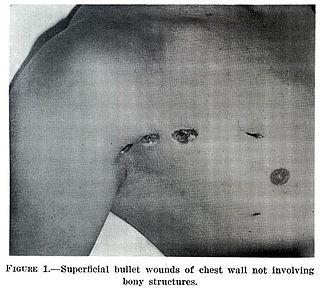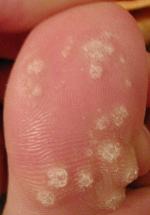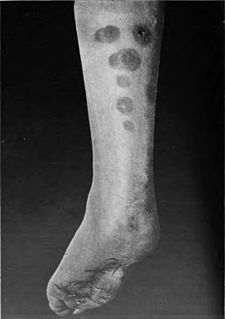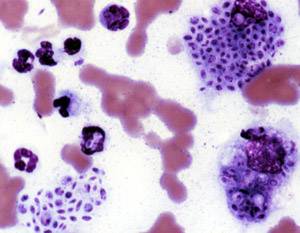| Prosector's wart | |
|---|---|
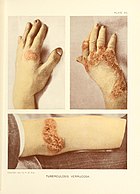 | |
| Classification and external resources | |
| Specialty | infectious disease |
| ICD-10 | A18.4 (ILDS A18.440) |
| ICD-9-CM | 017.0 |
Tuberculosis verrucosa cutis (also known as "lupus verrucosus", [1] "prosector's wart", [1] and "warty tuberculosis" [1] ) is a rash of small, red papular nodules in the skin that may appear 2–4 weeks after inoculation by Mycobacterium tuberculosis in a previously infected and immunocompetent individual.

A rash is a change of the human skin which affects its color, appearance, or texture.

Skin is the soft outer tissue covering of vertebrates with three main functions: protection, regulation, and sensation.

Mycobacterium tuberculosis is a species of pathogenic bacteria in the family Mycobacteriaceae and the causative agent of tuberculosis. First discovered in 1882 by Robert Koch, M. tuberculosis has an unusual, waxy coating on its cell surface primarily due to the presence of mycolic acid. This coating makes the cells impervious to Gram staining, and as a result, M. tuberculosis can appear either Gram-negative or Gram-positive. Acid-fast stains such as Ziehl-Neelsen, or fluorescent stains such as auramine are used instead to identify M. tuberculosis with a microscope. The physiology of M. tuberculosis is highly aerobic and requires high levels of oxygen. Primarily a pathogen of the mammalian respiratory system, it infects the lungs. The most frequently used diagnostic methods for tuberculosis are the tuberculin skin test, acid-fast stain, culture, and polymerase chain reaction.
Contents
It is so called because it was a common occupational disease of prosectors, the preparers of dissections and autopsies. Reinfection by tuberculosis via the skin, therefore, can result from accidental exposure to human tuberculous tissue in physicians, pathologists and laboratory workers; or to tissues of other infected animals, in veterinarians, butchers, etc. Other names given to this form of skin tuberculosis are anatomist's wart and verruca necrogenica (literally, generated by corpses).
An occupational disease is any chronic ailment that occurs as a result of work or occupational activity. It is an aspect of occupational safety and health. An occupational disease is typically identified when it is shown that it is more prevalent in a given body of workers than in the general population, or in other worker populations. The first such disease to be recognised, squamous-cell carcinoma of the scrotum, was identified in chimney sweep boys by Sir Percival Pott in 1775. Occupational hazards that are of a traumatic nature are not considered to be occupational diseases.

A prosector is a person with the special task of preparing a dissection for demonstration, usually in medical schools or hospitals. Many important anatomists began their careers as prosectors working for lecturers and demonstrators in anatomy and pathology.

Dissection is the dismembering of the body of a deceased animal or plant to study its anatomical structure. Autopsy is used in pathology and forensic medicine to determine the cause of death in humans. Less extensive dissection of plants and smaller animals preserved in a formaldehyde solution is typically carried out or demonstrated in biology and natural science classes in middle school and high school, while extensive dissections of cadavers of adults and children, both fresh and preserved are carried out by medical students in medical schools as a part of the teaching in subjects such as anatomy, pathology and forensic medicine. Consequently, dissection is typically conducted in a morgue or in an anatomy lab.
TVC is one of the many forms of cutaneous tuberculosis, such as the tuberculous chancre (which results from the inoculation in people without immunity), and the reactivation cutaneous tuberculosis (the most common form, which appears in previously infected patients). Other forms of cutaneous tuberculosis are: lupus vulgaris, scrofuloderma, lichen scrofulosorum, erythema induratum and the papulonecrotic tuberculid.

Tuberculosis (TB) is an infectious disease usually caused by Mycobacterium tuberculosis (MTB) bacteria. Tuberculosis generally affects the lungs, but can also affect other parts of the body. Most infections do not have symptoms, in which case it is known as latent tuberculosis. About 10% of latent infections progress to active disease which, if left untreated, kills about half of those affected. The classic symptoms of active TB are a chronic cough with blood-containing sputum, fever, night sweats, and weight loss. It was historically called "consumption" due to the weight loss. Infection of other organs can cause a wide range of symptoms.

Lupus vulgaris are painful cutaneous tuberculosis skin lesions with nodular appearance, most often on the face around the nose, eyelids, lips, cheeks, ears and neck. It is the most common Mycobacterium tuberculosis skin infection. The lesions may ultimately develop into disfiguring skin ulcers if left untreated.

Scrofuloderma is a skin condition caused by tuberculous involvement of the skin by direct extension, usually from underlying tuberculous lymphadenitis.
It was described by René Laennec in 1826. [2]
